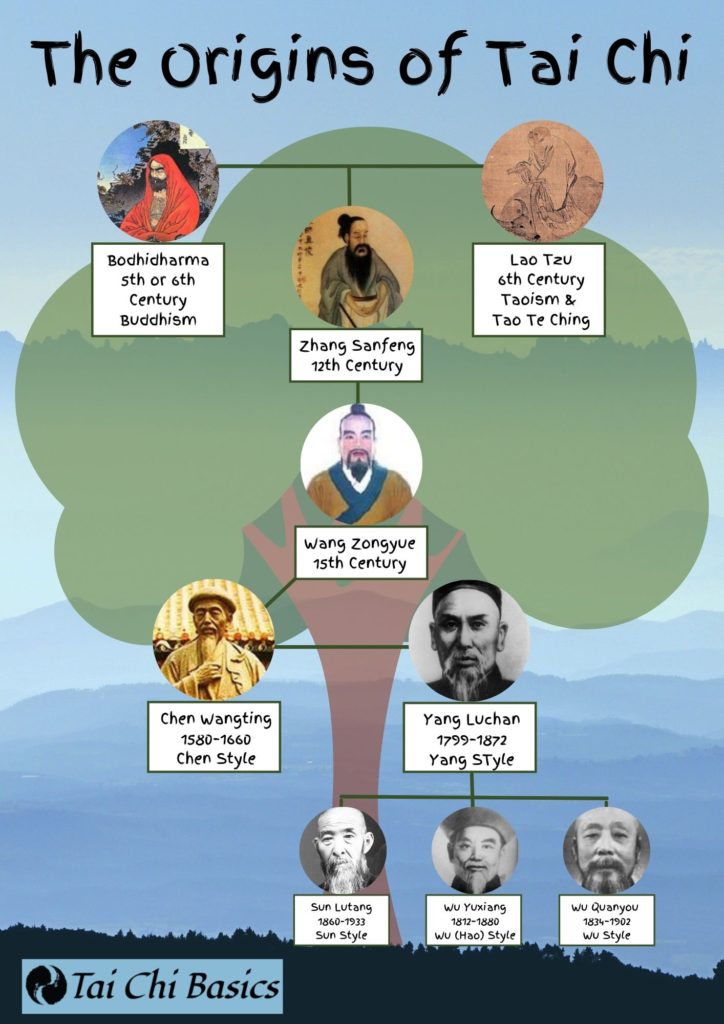There is really only one way to fully understand how vast and complex the teachings of tai chi are. We need to begin with the quintessential tai chi origin story and work our way up through tai chi history to arrive at our modern day legends. It’s an exciting trip through the past which lets us see how the early philosophies influenced the development of the forms that are practiced today.
The origin of tai chi is rooted in Eastern philosophies. The word tai chi (太極) means “supreme ultimate” and was first recorded in the Book of Changes. As the name suggests, it is an art that encompasses everything in the vast universe (supreme) and any changes from one opposite to the other (ultimate) that we experience.
While you could spend a lifetime learning about the origin of tai chi, I wanted to present it in an way that retains its excitement and is not overwhelming. For you, if you can understand the rich tradition that you are taking part in, you are more likely to become a life long practitioner and see the connection between the physical, mental, and philosophical aspects of tai chi. The goal of this article is to:
1) Introduce you to early tai chi history that led to the development of the different styles.
At some point in everyone’s development, an understanding of the tai chi origin story becomes essential. We all find ourselves in conversations about yoga, work, religion, running, etc. and think; “that sounds like tai chi.” A need arises to understand how tai chi can be related to so much simultaneously and your historical pursuit begins.
2000 years of development cannot be explained well in any small volume but your reason to join this great tradition can be.
2) Give you confidence in the great tradition that you are now part of.
It is humbling and exciting to know that by lifting your hands in the opening movements for the first time that you have just joined millions and billions across the centuries who are reconnecting with their internal energy. Tai chi is not typically what we grew up with. Development comes slowly at times and history provides us with a blueprint to know that we are building something truly better and unique for ourselves. Let’s meet the original tai chi legends and their work which resulted in the tai chi we have today.
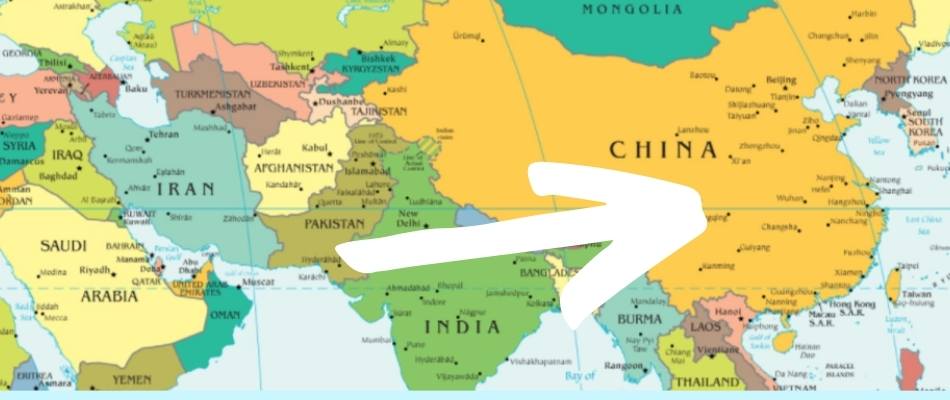
The Origin of Tai Chi
If we are tracing tai chi’s lineage back to the very, very beginning then we have to start with Bodhidharma, a monk who is credited with bringing Buddhism to China, Korea, and Japan from Central Asia. The exact year he arrived and the exact place he came from is debated. He was believed to have traveled from Northern India or Persia and is always depicted as non-Chinese and even described as a “blue-eyed barbarian.” His teachings and influence began to be seen in writings starting in the 5th Century.
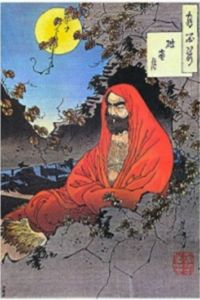
Bodhidharma stayed at the Shaolin Monastery for several years and found the monks to be weak in body and mind. He encouraged physical discipline and taught a yoga-based exercise set to extend and improve their meditation thereby improving their health and practice. A group of eighteen monks (now revered as Lohan – heroes) created a system of exercises (Shao-lin Chuan) that are the basis for all qigong and martial arts forms including tai chi chuan. This is party why tai chi gets confused with being a religion although it’s not.
In 722 AD Shao-lin received special acclaim from the Emperor who was visiting the area. Up through the 14th Century hundreds of external forms were developed based on movements in nature and also spread to neighboring Asian countries to create arts like Tae Kwan Do and Karate.
Taoism is Born and Has a Huge Influence on Tai Chi History
To accurately cover the tai chi origin story we need to sidestep historically for a moment to add Lao Tzu, the author of the Tao Te Ching and founder of Taoism, to tai chi’s lineage. Taoism, and specifically the collection of essays in the Tao Te Ching provide the philosophical foundation for tai chi’s teachings and movements. Taoism describes the origin of all things and how separation from this origin causes people to act in unnatural ways. It also explains opposing forces that develop when we separate from this one true source of movement and thinking.
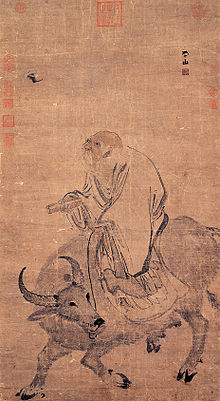
Tai chi, in basic terms, is a physical set of movements where we can understand wasted actions, opposites, opposing forces, and how to move in synchronicity with ourselves and others (pushhands). One popular way to understand this and translate it as a measure of progress is Yin Yang Theory. It’s a way for us to correct how stressed, stiff, disconnected we can be by showing us a more positive, opposite direction.
There are dozens of theories about where Lao Tzu came from. Several lineages claim him. Some believe he is entirely fictional as “Lao Tzu/Laozi” is simply an honorific meaning “Old Master/Teacher.” There is even strong evidence to suggest that the Tao Te Ching is a compilation of the the writings of several Taoist masters, not just one. What’s important is that the Tao exists and that we have a living, moving art to practice it and understnd it. Here’s the most common story but if you are interested in the most popular ideas of his history, Wikipedia does a great job summing them all up.
Lao Tzu originated from Central China in what is now the states of Hubei and Hunan. He was part of an educated class and became a scholar who worked in the Zhou royal court archives. This gave him access to the great library of classics that the Yellow Emperor had amassed and led to the development of his theories which would become Taoism or The Way. Lao Tzu never taught formally but attracted many students who wanted to learn from him. As the kingdom declined, Lao Tzu grew tired of urban living and left his post to head west and live a life of solitude. As he passed through the city’s gate on his ox, a guard named Yinxi recognized him an begged him to record his knowledge before leaving the civilized world. This documented knowledge became the Tao Te Ching.
Do you believe it? All accounts are great stories and what is important is how tai chi legends that followed used this knowledge to create tai chi and the internal arts.
The Internal Arts are Created and the First Tai Chi Form
Our next stop as we travel through tai chi history is with a Taoist teacher and martial artist from the 12th Century. Here we start to see the roads of Buddhism (Bodhidharma), Martial Arts, and Taoism (Lao Tzu) meet. Zhang Sanfeng, a Confucius and Taoist master, held a civil service position and traveled for the government. He was also an accomplished martial artist having learned White Crane and Snake Styles as well as sword fighting. This makes sense historically as he would need these skills to be able to travel safely and fulfill his post.
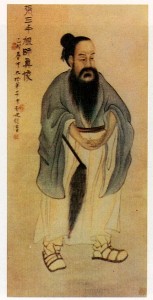
A point comes in Zhang Sanfeng’s life where his position and possessions become secondary to what he has learned through his philosophical studies. He renounces his post and position, gives away his possessions, and begins traveling as ascetic.
Zhang’s travels took him west where he settled for a time in the Wudang Mountains. Wudang has been home to Taoist Monasteries for centuries. It is here where he combines his knowledge from the “external” martial arts with his knowledge of the “internal” philosophies to develop the internal martial arts. We know this because thankfully Zhang Sanfeng was a prolific writer and recorded his thinking in five books!
As this tai chi origin story relates; Zhang watched a bird and snake fight and was awestruck by the calm composure that the snake held under the birds relentless and aggressive attack. And then, in a single move, the snake unleashed all of it’s power to end the battle. He dedicated himself to the development of a non-violent form of practice or soft “internal martial art” that relied on energies from within. His efforts were based on medical knowledge and Taoist philosophy and resulted in the development of a series of 72 external movements that embodied internal development. This style of tai chi is still practiced in Wudang Mountains to this day.
The First Three Tai Chi Origin Legends – Disciples of Zhang Sanfeng
Tai Chi Legend Wang Zongyue
As Zhang Sanfeng united his theories into his writings he began to attract students. Wang Zongyue purportedly studied under Zhang and was himself a scholar. Most notably, he produced the Tai Chi Treatise which is known to all practitioners as the primary Tai Chi Classics. In it he describes the purpose of the movements and adds additional structure to the forms. If you are a fan of the many tai chi sayings that populate the walls of tai chi schools, chances are you are reading Wang Zongue’s original words:
“Four ounces deflect one thousand pounds.”
Wang Zongyue
As we continue on from tai chi’s origin through to the modern masters, we arrive at the place in time where tai chi lands in Chen Village. We have one last bit of juicy historical intrigue to talk about here because the birth of tai chi in Chen village is another BIG debate. Hang with me though. After this we enter the 17th Century and there is a lot more documentation of tai chi lineage and a lot fewer questions.
Tai Chi Legend Jiang Fa
Wang Zongyue had many notable students who became masters of tai chi in their own right. Jiang Fa was a martial artist who came from Zhao Bao, a village in Hebai Provence near Chen Village. Jiang Fa returned home with his knowledge and founded the style which is now known as Zhao Bao Tai Chi Chuan. It went largely unheard of because the style was only taught to decedents of the village practically until the 21st Century.
Tai Chi Legend Chen Wangting
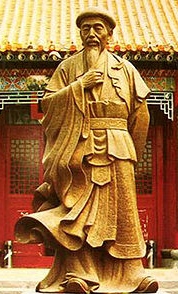
Chen Wangting was a military officer born in Chen Village. Through his career, he rose in rank becoming commander of a military garrison and overseeing trade routes throughout Central China. You can imagine that through his rank and prestige, as well as the nature of his job, he was able to travel quite a bit. The literature is a bit unclear as to if he studied directly under Wang Zongyue. What is undisputable is that Wong Zongyue’s forms being practiced in Wudang Mountain, the martial arts of the Shaolin Monasteries, and the writings from Lao Tzu and the Tai Chi Treaties all influenced the development of tai chi.
When Chen Wangting retired, he returned to Chen Village and began teaching. His legacy has had the greatest impact on what most of us would recognize as tai chi. He created and documented several tai chi forms. Most notably, he created the first 108 movement long form and a faster version called Cannon Fist which showcased what he learned in the military and external martial arts. Unlike Jiang Fa’s work in Zhao Bao Village, Chen Wangting’s lead student Chen Changxing began teaching “outsiders” which lead to the development of Yang tai chi and all the families that followed.
The Five Modern Styles of Tai Chi Lineage
The five major styles of tai chi are named for the Chinese families who originated them. All of them are natural transitions from the tai chi lineage described above. We dedicated separate essays to each style:
Chen style (陳氏) of Chen Wangting (1580–1660)
Yang style (楊氏) of Yang Luchan (1799–1872)
Wu Hao style (武氏) of Wu Yuxiang (1812–1880)
Wu style (吳氏) of Wu Quanyou (1834–1902) and his son Wu Jianquan (1870–1942)
Sun style (孫氏) of Sun Lutang (1861–1932)
Summarizing the Tai Chi Origin Story
1400 years of philosophical thinking on nature, and the body’s processes resulted in the development of Taoism and the Internal Energy Arts (Neigong). Masters of the external styles applied internal knowledge to the movements and development ensued for 500 more years resulting in the first tai chi forms. This continues with five main families and with you. By practicing tai chi you consciously decide to join the long tai chi history and work to understand the inherent power that your body was intended to manifest.
You can read about some of the current tai chi legends in the interviews of: Chen Taijiquan: Masters and Methods



